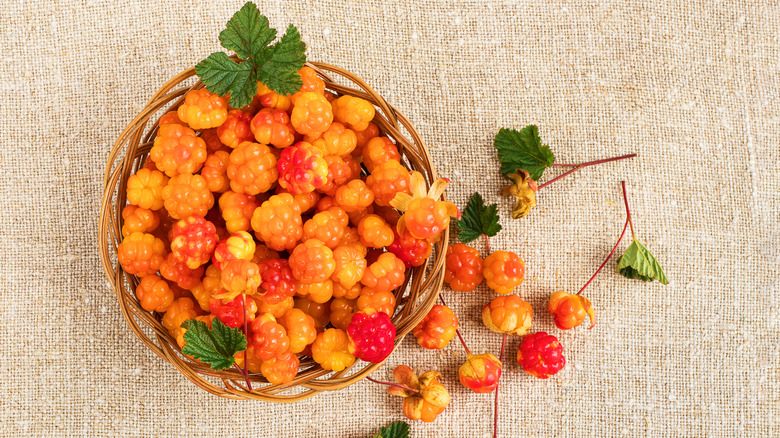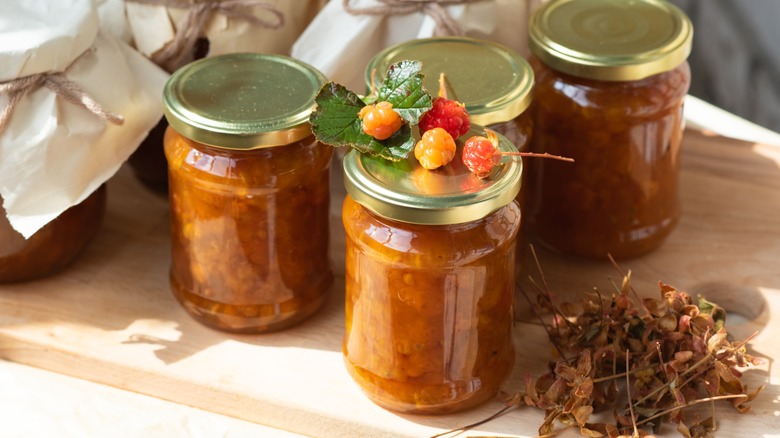Cloudberries Are Whimsical Fruits That You'll Be Lucky To Try
As the weather warms, juicy brambles like raspberries and blackberries grow on vines, ready to be picked and made into jams and fruity pies. One such fruit that you may not be as familiar with is the cloudberry. As precious and equally elusive as their name hints at, cloudberries are quite rare and coveted in regions of the world with polar climates. They are not cultivated by farmers, but rather foraged in the boreal forests of countries including Finland, Sweden, Norway, Poland, and Russia. In North America, they can also be found growing in Canada and Alaska.
Sometimes called "Arctic gold," the perennial fruit has a juicy clustered appearance, similar to small raspberries, and a vivid orange hue. Like strawberries, they grow on stems of fruiting flowers that crop up year after year in the spring and ripen, ready for the picking in July. The fleeting berry has a very short window for harvesting once ripe and its season is usually complete by mid-August. The sought after cloudberries are found few and far between, making them quite prized by local foragers and artisan chefs alike, and there are often local regulations when it comes to picking the fruit in order to preserve their role in natural ecosystems.
The fruit has a coveted, unique flavor
Due to their rarity, the flavor of cloudberries is meant to be savored. The fruit is juicy, tart, and sweet like other berries, and some describe the taste as slightly bitter and even savory once cooked over low heat in a saucepan to make jams, compotes, and fruit fillings. Overripe berries are known to develop a creaminess as they mature, which makes them a delicious addition to rich, custardy desserts.
While they are a treat eaten on their own, you can cook and bake with cloudberries just like you would with raspberries, blackberries, or strawberries. If you are in a region where they grow or are lucky enough to get your hands on the fruit often treated as a delicacy in Nordic regions, they are often sold in small quantities. Use them wisely in desserts as an excellent and inventive take on classic bakes like blackberry cobbler and mini fruit-filled pies, or to craft homemade jams or jellies to serve along a charcuterie board with cheese.
Cloudberries can add intrigue and flavor to a variety of savory dishes, as well. Toss them into salads alongside chicken, or use as a delicate garnish to grilled cod steaks to add a flavorful burst of color to the plate. To preserve the special fruit to use at a later time or on special occasions, lay them out on a prepared baking tray and transfer to the freezer.
How to find cloudberries
Unless you live in or are traveling to a region where they are native, it is likely that you could go on living your whole life not knowing that the prized cloudberry exists. Luckily, now you know. While the berries can be found foraged in regions where they grow naturally, some fine dining restaurants in other regions may source them and feature them as a special culinary touch in their dishes.
If you want to try the delicate fruit out for yourself, but live somewhere where they don't grow, you can buy cloudberry jam at specialty food stores or online. In fact, IKEA actually sells an organic cloudberry spread that looks like it would seriously elevate your morning breakfast toast. You can also experience cloudberries by trying a Finnish liqueur called lakka, which is made from mashed berries and infused with honey and warm spices. Do note that if you find cloudberries or their products, they usually are quite expensive due their scarcity.


